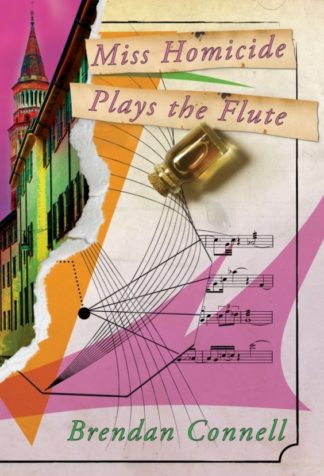By BRENDAN CONNELL (Eibonvale Press; 2013)
Here’s how Eibonvale Press categorizes this typically atypical novel by Brendan Connell: “Fiction, Mystery/Thriller, Science Fiction/Fantasy/Horror.” Content-wise it’s sold as “A relentless symphony of pleasantries and things unpleasant sketched with the inimitable style of a master’s hand.” I couldn’t have put it better myself!
In light of the author’s 2012 novella THE ARCHITECT, one of his most accessible offerings, MISS HOMICIDE PLAYS THE FLUTE is downright avant-garde. Particularly notable is Connell’s highly playful and inventive use of language, resulting in one paragraph printed backward (complete with a note instructing that it’s “to be viewed in a mirror”) and sentences like “Rotting meat spoiled polluted odour corruption frozen stock-shot burgundy liver perfume seaweed fat to the tune of starfish.”
There’s also a narrative, believe it or not, about Serena, a flute playing, art loving contract killer on assignment in Europe.The babe assassin may be one of the overused clichés in existence, but Brendan Connell’s treatment, you can be sure, is anything but clichéd. Think of it as LA FEMME NIKITA reconfigured as a neo-decadent hallucination.
Leslie, a Zurich based dealer of stolen artwork, is Serena’s first victim (although a listing informs us she previously murdered nine people). She’s next contracted to off Pier, a 20-year-old Italian transvestite. Carrying out this killing proves far more arduous than the other, as Serena has trouble coming up with a suitable way to commit the murder. She also becomes unwittingly entangled in Pier’s eccentric family, in particular his younger brother Glauco, who ordered the hit, and his lesbian mother Gemma, who develops an insatiable attraction for Serena. Pier, meanwhile, turns out to be a voracious shoe fetishist as well as a cross dresser, which only further complicates Serena’s job.
The insanity of the story is complimented by the author’s miscellany, if miscellany is even the correct term for the odd dreams, lengthy “recipes” of murderous methodology, brief glimpses of Hell (“…and the sinners suffering therein–them being fried in great pans, chopped into little bits with huge hatchets”), lengthy descriptions of the artwork the heroine admires and overall obsession with ancient Greece (evident in passages like a description of a nightclub that devolves into a highly eccentric dissertation on Greek dance). Such things may qualify as deviations from the main narrative, or perhaps it’s the other way around. Either way this is a fascinating oddity that resembles nothing so much as itself.

